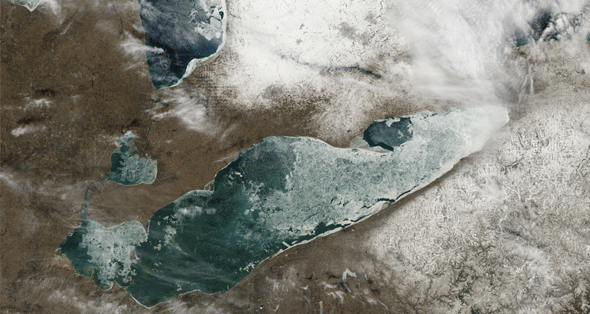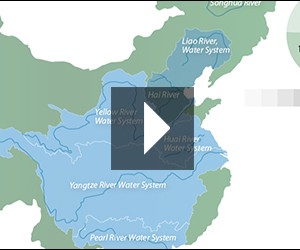Business vs. Environment: Ohio Governor Vetoes Lake Erie Water Withdrawal Bill
The highly controversial bill set the highest thresholds for water withdrawal permits in the Great Lakes region, sparking debate between environmentalists and businesses over the use of Lake Erie water.

By Codi Yeager
Circle of Blue
On Friday, Ohio Governor John R. Kasich vetoed legislation that would have allowed industry, agriculture, and municipalities to withdraw huge amounts of water without public oversight. House Bill 231, which was approved by the Republican-led Legislature earlier this month, exempted big water users from state water withdrawal permits unless they took more than 5 million gallons (19,000 cubic meters) a day from Lake Erie, the shallowest of the Great Lakes.
Critics of the measure—among them former Governor Bob Taft and other prominent Ohio Republicans—said that if the proposal were to be signed, it would dramatically weaken the regional compact to secure the Great Lakes from excessive withdrawals; a compact that was approved by every Great Lakes state and signed into law in 2008 by President George W. Bush. The Republican governor of Michigan, Rick Snyder, and the Democratic governor of New York, Andrew Cuomo, also urged Ohio’s Republican governor to veto the bill.
In a letter to Governor Kasich last week, Alliance for the Great Lakes, an advocacy group with offices in Ohio and three more Great Lakes states, warned of the damage the Ohio House proposal would have on the credibility of the Great Lakes Compact.
“We look to you for leadership and guidance to stop a flawed bill that, if signed into law, will directly conflict with many provisions in the Compact and seriously undermine Ohio’s ability to use and protect one of its greatest natural assets,” said Joel Brammeier, the group’s president and chief executive.
The bill was the strongest legal challenge yet by a Great Lakes state to water protection provisions of the Great Lakes-St. Lawrence River Water Resources Compact, which was ratified by all eight states that border the Great Lakes—Minnesota, Wisconsin, Illinois, Indiana, Michigan, Ohio, Pennsylvania, and New York. The Compact is intended to protect against water diversions outside of the Great Lakes Basin, which contains about 20 percent of the world’s available freshwater resources. The Compact mandates that each state implement a regulatory permit program for water withdrawals inside the Basin by December 2013.
“You could conceivably drain a river dry and not be denied a permit.”
— Josh Knights
Executive Director (Ohio)
The Nature Conservancy
The proposal to allow daily withdrawals up to 5 million gallons (19,000 cubic meters) in Ohio without a permit was supported by business interests, including the Toledo Regional Chamber of Commerce. State Senator Cliff Hite, the Republican Chairman of the Senate Agriculture, Environment, and Natural Resources Committee, told reporters he was disappointed by the veto. He said other states may have been jealous of Ohio’s legislation and worried that such a generous standard could become a competitive advantage.
“There are many states that don’t like our compact language, because it is better than theirs. It is very, very advantageous to business, as well as protecting our environment. I think we came up with a home run,” Senator Hite said.
Governor Kasich, in a statement, disagreed.
“Lake Erie is an incredible resource that demands our vigilant stewardship to maximize its environmental, recreational, and commercial potential for Ohioans,” he said. “The Great Lakes Compact ensures that Great Lakes states and provinces work together to protect the lakes and the water resources in the basin, and Ohio’s legislation is intended to further Ohio’s compliance with the Compact. Ohio’s legislation lacks clear standards for conservation and withdrawals and does not allow for sufficient evaluation and monitoring of withdrawals or usage.”
Michigan has already established requirements that call for water users to secure state permits if they intend to withdraw more than 2 million gallons (7,500 cubic meters) a day. In June, New York approved rules that require high-capacity well owners and certain businesses and individuals to apply for a state permit to withdraw 100,000 or more gallons (380 cubic meters) of water per day in any 30-day period.
The Ohio measure would have required permits for users that wanted to withdraw more than:
- 5 million gallons (19,000 cubic meters) per day from Lake Erie
- 2 million gallons (7,500 cubic meters) per day from rivers and groundwater
- 300,000 gallons (1,100 cubic meters) per day from a select group of high quality streams
Environmental groups protested the proposal as too generous to big water users.
“This has been a bad bill from the beginning,” Josh Knights, executive director of The Nature Conservancy in Ohio, told Circle of Blue. “It provides for permits that are meaningless and violates the spirit of the Compact.”
Knights said The Nature Conservancy opposed the bill for three reasons:
- The thresholds to apply for a permit were too high, allowing for water withdrawals that could harm the ecology of shallow Lake Erie.
- The way in which the state determined if water withdrawals posed a significant adverse impact was not based on science and did not give the Ohio Department of Natural Resources — charged with issuing the permit — the ability to deny permits based on ecological considerations specific to a certain location.
- The bill asked water users to implement feasible conservation measures — which the Compact requires — but left these to be determined solely by the water user, without any requirements from the state.
One of the biggest concerns was that permits could only have been denied if the withdrawal was determined to have a significant adverse impact on the Lake Erie Basin as a whole. The environmental consequences of a withdrawal would only have been considered significantly adverse if it took more than 1.5 percent of the long-term annual mean runoff from Ohio’s Lake Erie Basin. This translated into 90 to 100 million gallons (340,000 to 380,000 cubic meters) of water per day from streams that have Lake Erie backwater influence and 45 to 50 million gallons (170,000 o 190,000 cubic meters) of water per day that could be removed from stream reaches not influenced by Lake Erie water levels, according to an email from John Stark, the freshwater conservation director at The Nature Conservancy in Ohio, to Circle of Blue.
“You could conceivably drain a river dry and not be denied a permit,” Knights said of the process.
Marc Smith, a senior policy manager at the National Wildlife Federation, agreed. “We want science to tell us how to manage the Great Lakes,” he told Circle of Blue. “We should not rely on some arbitrary number that is pulled out of a hat. The Great Lakes are too important. Lake Erie is too important.”
But the bill’s proponents argued that it would have protected Lake Erie and pointed out that, currently, there are no regulations for water withdrawals at all.
“People who think this is going to drain the Great Lakes simply don’t understand the bill and are trying to scare people to oppose it.”
— Lynn Wachtmann
Ohio State Representative
“We wholly believe it complied with the Compact and is protective of the resource,” Jenn Klein told Circle of Blue. Klein is the director of energy and environmental policy at the Ohio Chamber of Commerce. “There is currently not a regulatory program for [water] withdrawals. The idea that putting in place a permitting program is more damaging than having none at all is frustrating and disingenuous. We are not removing protections; we are adding protections.”
The Ohio Chamber of Commerce represents over 6,000 companies, many of which use water. “We need water just as badly as anyone else,” Klein said. “If it is not there, our members are not in business. We would never support anything that would impede our ability to have that water now or going into the future.”
“People who think this is going to drain the Great Lakes simply don’t understand the bill and are trying to scare people to oppose it,” Ohio State Representative Lynn Wachtmann, the bill’s Republican sponsor, told Circle of Blue.
Wachtmann said that the bill not only adhered to the Great Lakes Compact, but that it also assured businesses and allowed them access to water without heavy regulation. Ohio’s water permit thresholds — which are comparable to Indiana’s and higher than those in neighboring Michigan and Pennsylvania — would have given the state a competitive advantage in attracting businesses, he added. But they won’t destroy Lake Erie.
“The Great Lakes compact that was passed assures there can be no withdrawals outside of the Lake Erie Water Basin,” he said. “This legislation cannot, could not, and will not change that.”
James Olson, an attorney and water law specialist in Traverse City, Michigan, however, said passage of the Ohio proposal would have weakened the Great Lakes Compact.
“House Bill 231 demanded that water be treated as a commodity,” said Olson in an email message to Circle of Blue. “The Compact says it is not. An international side agreement between Canada, Mexico, and the U.S. to the Compact says it not. Two thousand years of water law recognizes water in Lake Erie — like all Great Lakes — as public. The right to use is subject to public and sovereign interest, despite statements of Ohio to the contrary, and it certainly doesn’t include ‘commodity’ or ‘sale.’”
Codi Yeager is a journalism student at West Virginia University and a Traverse City-based reporter for Circle of Blue.
Sources: Council of Great Lakes Governors, Michigan Bar Journal, Ohio Chamber of Commerce
A news correspondent for Circle of Blue based out of Hawaii. She writes The Stream, Circle of Blue’s daily digest of international water news trends. Her interests include food security, ecology and the Great Lakes.
Contact Codi Kozacek










Leave a Reply
Want to join the discussion?Feel free to contribute!